![]()
![]()
![]()
Use LEFT and RIGHT arrow keys to navigate between flashcards;
Use UP and DOWN arrow keys to flip the card;
H to show hint;
A reads text to speech;
106 Cards in this Set
- Front
- Back
|
Dada |
"Dada is the revolt of the nonbelievers against disbelief, Dada is the longing for belief" - Jean Arp *Irony, deconstruction, funny/silly/puns, but with underlying themes of seriousness *Revolting against pillars of European power - the ill effects of progress such as technology, machine guns, tanks, science, modernity *Liked to find something they believe in, but can't find it *Enlightenment of logical, rational, reasonable didn't work -> take on a new perspective of illogical, irrational, and unreasonable |
|
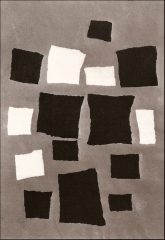
|
Jean (Harp) Arp "Squares Arranged According to the Laws of Chance" 1916-17 Dada *Tore up pieces of paper and instead of figuring out a composition, he dropped them onto the paper and wherever they landed, he glued them down *He TORE them instead of cutting them so as to leave the shapes up to chance (not precise) |
|
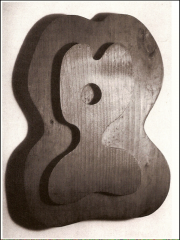
|
Jean (Harp) Arp "Torso Navel" 1915 Dada *Laid strings down on cardboard, made a model, and presumably created "Torso Navel" *Accidental *Almost like working backwards (sillyness with a purpose) |
|
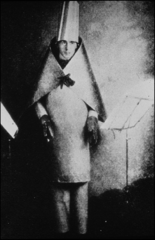
|
Hugo Ball Reciting "Karawane" at the Cabaret Voltaire 1919 Dada *Primitive hope to discover something less spoiled by modern western cultures *Affected the subsequent course of 20th century poetry |
|
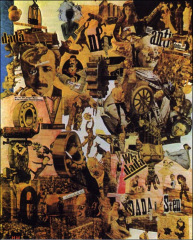
|
Hannah Hoch "Cut with the Kitchen Knife Through the Beer Belly of the Weimar Republic" c. 1919 Berlin Dada *Satirical panorama of the Weimar society *Kitchen knife=women belong in the kitchen, acts as her weapon *Through the beer belly=cutting through the oppressive men; German norm is to drink a lot of beer *Found materials *Became 1 of the most influential people of Dada movement, but was difficult for her to get acknowledged *Commentary on the men of Dada and the German government *States her passion for the art movement ("Dada is not a trend") and her feminist perspective |
|
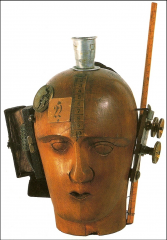
|
Raoul Hausmann "Mechanical Head (Spirit of the Age)" c. 1920 Berlin Dada *Commentary on the mindlessness and stupidity of humans (Germans), the human condition *Mechanical, robotic *The head is defined by the objects stuck to it *Gets audience to start thinking about what it means *Partook of the iconoclastic spirit of Duchamp's readymades and implied that human beings had been reduced to mindless robots, devoid of individual will. |
|
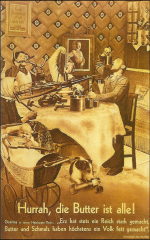
|
John Heartfield "Hurray, The Butter is Finished" cover for AIZ December, 1935 Berlin Dada *Dinner=German weapons of mass destruction |
|

|
John Heartfield "Adolf Superman Swallows Gold and Spouts Trash" 1932 Berlin Dada *Superimposed photomontage |
|
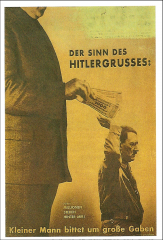
|
John Heartfield "The Meaning of the German Salute: Little man asks for big gifts, motto: Million stand behind me" 1932 Berlin Dada * |
|
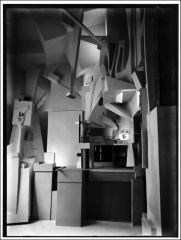
|
Kurt Schwitters "Hanover Merzbau" 1923 Berlin Dada *Wasn't wanted in the Dada movement *Total work of art *Structure grew throughout 1920's with successive accretions of every kind of material until it filled the room *Environmental construction *Structure lead a life of its own |
|
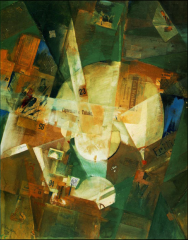
|
Kurt Schwitters "Picture with Light Center" 1919 Berlin Dada *Compare to Carlo Cara's "Patriotic Celebration" *Hope, not completely nihilistic/distopian mindset of Dada -> makes him more modern *Could extract elegance from lowly found materials |
|

|
Francis Picabia "Amorous Procession" (Parade of Lovers) 1917 NY Dada *All mechanisms are dependent upon each other and need each other (love) *Sexual terminology associated with machines *Female and male parts interlocking *Forms shape of a heart *No specific representation of female/male parts *Anthropomorphic, allegorical representation, personification *Some humor: celebrating machines as a way to enlighten the world (spoof) *Concept of love made into these mechanical objects *Mechanomorphs=concept of transformation enticed Dada artists |
|
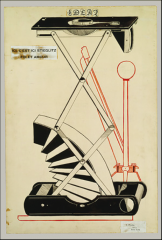
|
Francis Picabia "Here, This is Stieglitz Here" 1915 NY Dada *"Poster portrait" *subject matter=old camera *Shows Stieglitz as a fool in love (with what he does) |
|
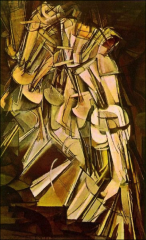
|
Marcel Duchamp "Nude Descending a Staircase No. 2" 1912 NY Dada *Not sensual *Deconstruction, cubism, futurism, created in spite of Dada *"Explosion in a single factory" *Not received well by the public |
|
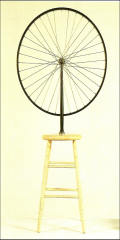
|
Marcel Duchamp "Bicycle Wheel" 1913 NY Dada *"ready-made" *If you paint a painting, you're using 2 ready-made materials to create art - you didn't make the paint or the canvas but you stuck them together just like he took a bicycle wheel and a stool and stuck them together to create a work of art *the conception, the discovery was what made a work of art, not the uniqueness of the object |
|
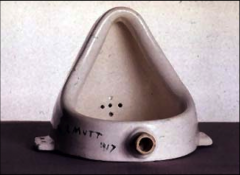
|
Marcel Duchamp "Fountain" 1917 NY Dada *Lyrical/poetic - transformed the urinal into something else *Used humor and antagonism to question the definition of a work of art *Titled it, signed & dated it and used artistic pseudonym: R Mutt in order to acknowledge the history of the object because R Mutt was the supplier of these urinals |
|
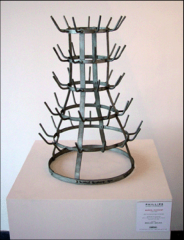
|
Marcel Duchamp "Bottle Rack" 1913 NY Dada *Literally took a bottle rack, signed & dated it, stuck it in a museum and called it art *Accepted by public, while "Fountain" wasn't |
|

|
Morton Schamberg "God" 1917 NY Dada *Plumbing=greatest achievement, exalted *Supplies water, water gives life... *Used irony to make us laugh but also make us think |
|

|
Marcel Duchamp "The Bride Stripped Bare by Her Bachelors, Even (The Large Glass)" 1915-23 NY Dada *Using Dada to challenge art; offer ideas about what art should be/could be *Destined to be his greatest work *"The green valise" (suitcase): where he stored his notes, plans, materials for his piece *Window frame with 4 pieces of glass *Mono-facial (made to be seen from 1 side) *Accidental processes, collage and paint and other things sandwiched between the glass *Squares=reference to "squares arranged by the laws of chance" *Cloud of dust=sperm gas *Bachelors separated from the bride; they're in a different glass plane *Chocolate grinder (thing that looks like an alarm clock) = "grind your chocolate" - French euphemism for masturbating *Catherine Dryer wanted it, and while moving it, it was dropped and the glass cracked - Duchamp was happy that now it was finished *"window into separate reality" *Assumptions of art being "stripped bare" *the whole construction becomes a paradigm of pointless erotic activity |
|

|
Marcel Duchamp "Tu m'" 1918 NY Dada *Masterfully created illusionistic tear in the canvas, highlighted by real safety pins *Corkscrew=pun; Screwing with you - what is real and what is painted *3 physical found objects: tack, safety pins, bottle brush *References to his past works |
|
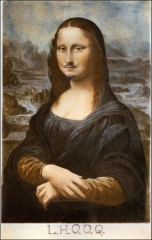
|
Marcel Duchamp "L.H.O.O.Q" 1919 NY Dada *Postcard from the Louvre and "aided" it (didn't deface/vandalize it, but helped it along) *Commentary on what we value and why we value it *Title read in French = "She has a hot ass" |
|

|
Kathe Kollwitz "Working Class Woman in Blue Scarf" 1903 German Expressionism *Pacifist, social activist, cared for others, esp. the poor *Skilled painter, but deliberately chose print making because it enabled her to disseminate her artwork to the public inexpensively *Identified with working class/poor, lived among them even though she earned enough money and could have lived a life of luxery |
|
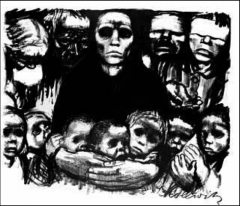
|
Kathe Kollwitz "The Survivors: Make War on War" 1923 German Expressionism |
|
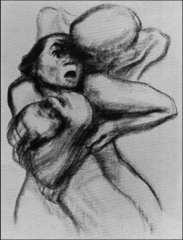
|
Kathe Kollwitz "Death Seizing a Woman" 1934-36 German Expressionism |
|
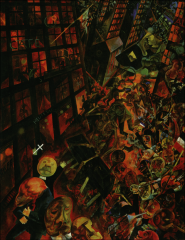
|
George Grosz "Dedication to Oscar Panizza" 1917 New Objectivity *Panizza=Italian playwright, imprisoned for "immoral" play he's written -> inspiration for Grosz to paint this *Deliberately uses different directions/planes to make it chaotic and claustrophobic to make the viewer feel uncomfortable *Larger subject="Mankind gone mad" *Shows a funeral turned into a riot *Humanity is swept away into hell of its own making *Grosz controls the chaos with the geometry of the buildings and the planes into which we segmented the crowd |
|
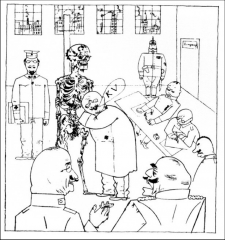
|
George Grosz "Fit For Active Service" 1918 New Objectivity *Shows Grosz's detestation of bureaucracy, with a fat complacent doctor pronouncing his "O.K" of a desiccated cadaver before arrogant Prussian-type officers |
|

|
George Grosz "Pillars of Society" 1926 New Objectivity *Press: chamber pot on his head *Magistrate: steaming pile of sh*t for brains *Soldier in front: drinking, sword in hand, swastika on tie *Academic=red nosed *All not paying attention to what is going on around them - all kinds of destruction going on in background |
|
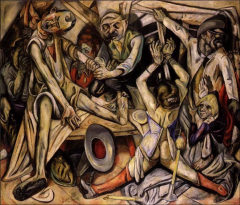
|
Max Beckmann "The Night" 1918-19 New Objectivity
|
|
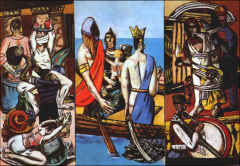
|
Max Beckmann "Departure" 1932-33 New Objectivity *Right: shows frustration, indecision, and self-torture *Left: Sadistic mutilation and the torture of others - refers to rise of dictatorship *Center: Freedom; "Freedom is the one thing that matters-it is the departure, the new start" |
|
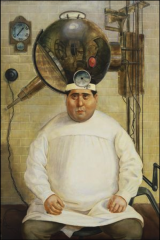
|
Otto Dix "Dr. Mayer Hermann" 1926 New Objectivity *Superrealism *Magic Realism=a mode of representation that takes on an aura of he fantastic because commonplace objects are presented with unexpectedly exaggerated and detailed forthrightness *Nothing bizarre or extraneous happening in the scene, but there is an overpowering confrontation that gives a sense of the unreal |
|
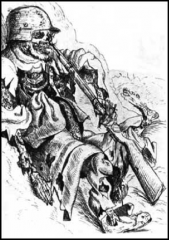
|
Otto Dix "Trench Suicide" 1924 New Objectivity |
|
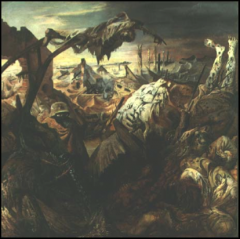
|
Otto Dix "Trench Warfare" 1932 New Objectivity *Destroyed in bombing |
|
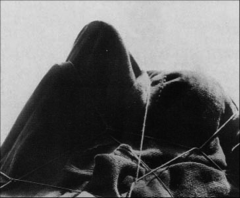
|
Man Ray "Enigma of Isidore Ducasse" 1920 Surrealism *"As beautiful as the chance encounter of a sewing machine and an umbrella on a dissecting table" |
|
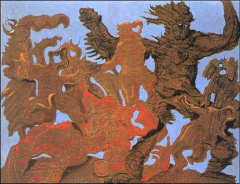
|
Max Ernst "The Horde" 1926 *Frottage = "rubbing"; random process; saw a "horde" of primordial, beastly creatures in his automatic drawings *ominous |
|
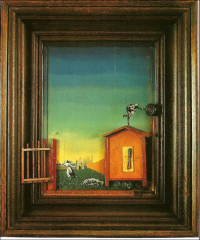
|
Max Ernst "Two Children are Threatened by a Nightingale" 1924 Surrealism/Dada *Wrote title on frame before he created the piece *Juxtaposition of words |
|
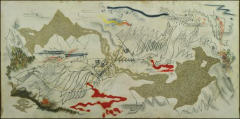
|
Andre Masson "Battle of the Fishes" 1926 Surrealist Automatism/Abstract Surrealism *Art could help cure/heal society (therapeutic) - deeply and spiritually scarred by experiences in WWI - raged against insanity of humankind and society *By nature, he was an anarchist - caused him to break away from Surrealist movement a couple times *His paintings contain various images relating to the sadism of humans and brutality of all living things *Mixed media: oil crayon, charcoal, liquid glue and added sand *he squeezed red paint straight from the tube which lessons the artist's control over the paint touching the canvas (Pollock); allowed chance to dictate his painting, but eventually broke away from method of frottage *Fish = anthropomorphic |
|
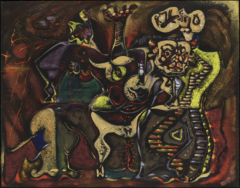
|
Andre Masson "Pasiphae" 1942 Surrealist Automatism/Abstract Surrealism *Minotaur: head of bull (id) body of human (sexual drive) *Pasiphae giving birth to a minotaur *Created by automatist line *He wanted to represent the violent union of woman and beast in such a way that its impossible to tell where one begins and the other ends |
|
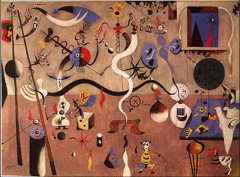
|
Jean Miro "Harlequin's Carnival" 1924 Surrealist Automatism/Abstract Surrealism *Harlequin=court jester, incorporated in plays as tragic and comedic figures *The grayish-beige room teems with life of the strangest variety *Animating the inanimate *Hybrid organisms that are very vivid *Many sources come from beyond his imagination - some based on nature, others stem from medieval art or art of his fellow surrealists *Creatures spread equally across canvas so the viewer's eyes don't stay in one place *He mapped out his compositional org. with red lines arranged in a diagonal grid *Picasso depicted in painting - Miro is paying homage to his mentor |
|
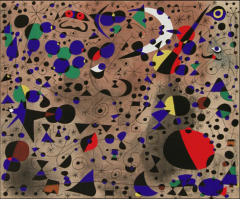
|
Jean Miro "The Poetesse" 1944 Surrealist Automatism/Abstract Surrealism *From collection, "Constellations" *Among his most intricate and lyrical creations *Concerned with ideas of flight and transformation as he contemplated the migration of birds, seasonal renewal of butterfly hordes, and the flow of constellations/galaxies |
|
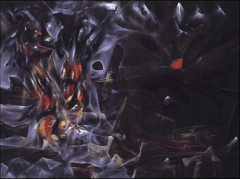
|
Roberto Matta Echaurren "Disasters of Mysticism" 1944 Surrealist Automatism/Abstract Surrealism *"Inscapes" (as opposed to landscapes); inter-cerebral landscape, primordial *Automatic drawing and then painted with rags soaked in oil paint and then rubbed over with turpentine (or other thin liquid) to create a smoky/airbrushed effect |
|

|
Salvador Dali "Persistence of Memory" 1931 Illusionistic Surrealism *Dali's "paranoiac critical method" *Ants devouring clocks = false memories of him and his brother *Influenced by mini medieval paintings *Denial of every 20th century experiment in abstract org. *Goes back to flemish art and chromolithographs *Presentation of recognizable objects in an unusual context, with unnatural attributes, and on an unexpected scale *Obsessed with the morphology of hard and soft *"nothing more than the soft, extravagant, solitary, paranoic - critical Camembert cheese of space and time *Matter is transformed from one state into another, is a fundamental aspect of surrealism |
|
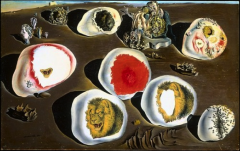
|
Salvador Dali "Accommodation of Desire" 1929 Illusionistic Surrealism *Dali's "paranoiac critical method" *Microscopic brand of realism that Dali skillfully deployed to objectify the dreamworld reached full maturity *Collage - Dali cute lion images from a book *Army of ants *Created this while courting Gala *Experience of intense sexual anxiety led him to paint this
|
|
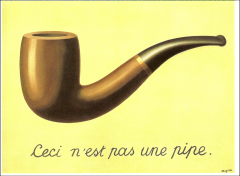
|
Rene Magritte "The Treachery (or Perfidy) of Images" 1929 Surrealism *"This is not a pipe" *Believing what you see, or believing what you read *Backwards semiotics *Presentation and then a destruction *Confounds pictorial reality and underscores Magritte's fascination with the relationship of language to the painted image *It undermines our natural tendency to speak of images as though they were actually the things they represented |
|
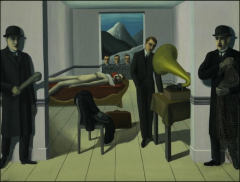
|
Rene Magritte "The Menaced Assassin" 1927 Surrealism |
|
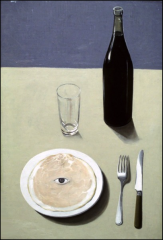
|
Rene Magritte "Portrait" 1935 Surrealism |
|
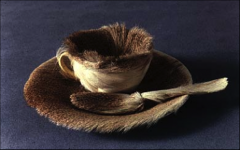
|
Meret Oppenheim "Object (Luncheon in Fur)" 1936 Surrealism *Has become the very archetype of the surrealist object *Idea originated in conversation with Picasso *Emblem of domesticity and niceties of social intercourse metamorphosed into a hairy object that is both repellent and eroticized, the consummate fetish *It revels in Freudian erotic ambivalence and sexual anxiety *How might an otherwise typical, functional object be modified so it represents something deeply personal and poetic? |
|
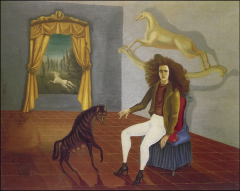
|
Leonora Carrington "Self Portrait (White Horse Inn)" 1936-7 Illusionistic Surrealism *Closely tied to Celtic mythology and memories of her childhood; also themes in her writing *White horse in window=a kind of liberated surrogate self *Freudian dream imagery - horses symbolize sexual desires |
|
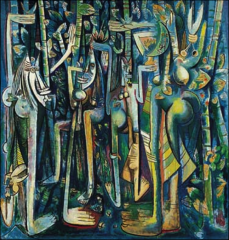
|
Wilfred Lam "The Jungle" 1943 Illusionistic Surrealism *Based in part on Santeria - blends mystical and ritualistic traditions of Africa with old-world catholicism |
|
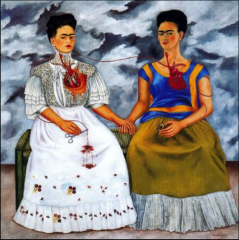
|
Frida Kahlo "Two Fridas" 1939 Illusionistic Surrealism *Intensely personal *divided self, depicts her own emotional struggles |
|
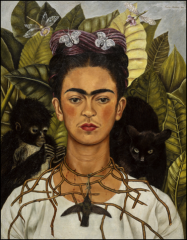
|
Frida Kahlo "Self Portrait with Hummingbird Necklace" 1940 Illusionistic Surrealism *What is she mourning? *Tormented self *Heroic - she is bearing herself in true form, not idealizing herself |
|
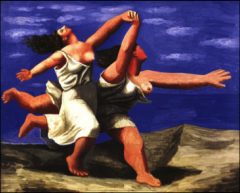
|
Picasso "Women Running" 1922 |
|
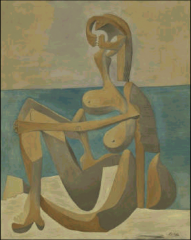
|
Picasso "Kneeling Bather" 1930 *Part of his phase of making figures compartmentalized into strange bone-like forms *highly sexualized bone figure *Simultaneously has the nonchalance of a bathing beauty and the predatory countenance of a praying mantis (Surrealists' favorite insect - apt metaphor for threatening female of Freudian theory) |
|

|
Picasso "Cover of First Issue of Minotaur" 1933 |
|

|
Joseph Cornell "Hotel Eden" c. 1945 Associated with Surrealism, although he preferred not to be labeled as a surrealist *Semiotics |
|
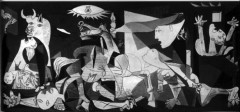
|
Picasso "Guernica" 1937 Cubism, Surrealism, art with social context *Inspired by the atrocities of the Spanish Civil War, specifically the bombing of the town of Guernica by German bombers *Returns to analytic cubism *Women=human protaganist *Central victim=speared horse (recurring subject in his works) *One of more searing indictments of war ever painted *Basic side of humanity, no moral explanation - "minotaur"=bull, symbol for spanish nationalism *Lamp resembles an eye - "light of reason", nothing showing reasonable explanation for this *After being blown up from an explosion, you can be disfigured, just like the figure in the painting - abstraction makes it more approachable, which subsequently makes it more disturbing |
|
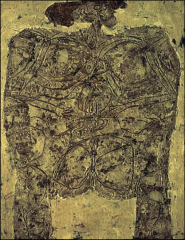
|
Jean Dubuffet "La Metaphisyx" 1950 *"L'art brut" (raw art) = basic, elemental, primal depiction of humanity Abstraction/Existentialism *"tachisme" (touchism) = Art through sensory experience (texture communicates raw art) *Metaphysics=understanding the meaning of it all *painted with sand, plaster, dirt, and lines drawn with crayon that scratches into the surface |
|
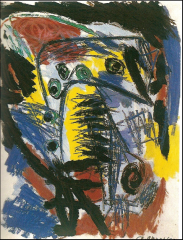
|
Karel Appel "A Figure" 1953 CoBrA Influenced by Kandinsky |
|
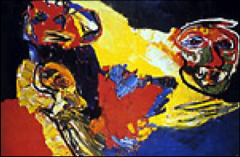
|
Karel Appel "Angry Landscape" 1967 CoBrA Influenced by Kandinsky and art of children *Heavy impasto and brilliant colors *Intuitive and spontaneous *"...learn it all...forget it and start again like a child...this is the inner evolution." |
|
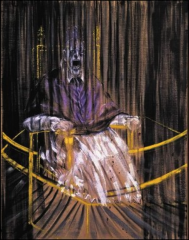
|
Francis Bacon "Study After Velazquez's Pope Innocent X" 1953 Abstraction/Existentialism *Influenced by Existentialism and Serge Eisenstein's avant-garde film, "Screaming Nurse" *Fascinated by slaughtered/prepared animals (like hanging meat in a butcher store) *"Make the best painting of the human cry" |
|
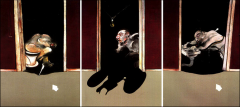
|
Francis Bacon "Triptych" 1973 Abstraction/Existentialism *Depicts his partner, George Dyer, dying of a deliberate overdose *Posthumous portrait *Dyer's ghostly white figure is seen through darkened doorways *Life as its most fundamental, when the human protagonist is stripped of all pretense and decorum |
|
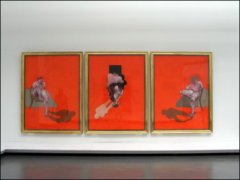
|
Francis Bacon "Triptych" 1983 Abstraction/Existentialism |
|
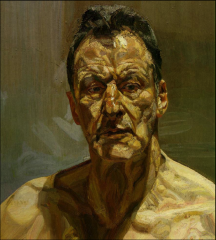
|
Lucien Freud "Reflection" 1985 Abstraction/Existentialism |
|

|
Alberto Giacometti "The Palace at 4am" 1932 Abstraction/Existentialism *Defining outlines of a house *Pterodactyl - "the skeleton birds that flutter with cries of joy at four o'clock" *The company of a woman: "We used to construct a fantastic palace in the nice...a very fragile palace of matchsticks" *Associations and reminiscences involved *wonderful, haunting quality of mystery |
|
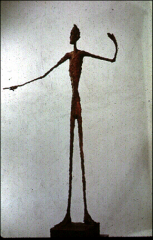
|
Alberto Giacometti "Man Pointing" 1947 Abstraction/Existentialism
|
|
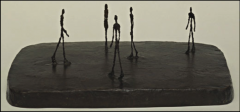
|
Alberto Giacometti "The City Square" 1948 Abstraction/Existentialism *Aftermath of WWII |
|
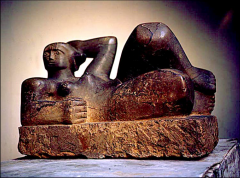
|
Henry Moore "Reclining Figure" 1929 Abstraction/Existentialism *May owe it original inspiration to "Chacmool" (ancient mayan), 7th century CE -distinctive in that they represent a reclining warrior holding an offering dish *Massive blockiness of Moore's figure stems from a passionate devotion to the principle of truth to materials - the idea that stone should look like stone, not flesh *Reduce subject matter to something essential *Simplified/abstracted (Matisse) |
|
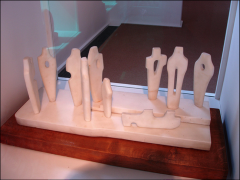
|
Barbara Hepworth "Group III (Evocation)" 1952 Abstraction/Existentialism *Heightens the tension between the geometric forms with their smooth and perfected finish through the precarious positioning of the sphere *Simplified sculpture with gently rounded/delicately indented to emphasize their organic, figurative source |
|
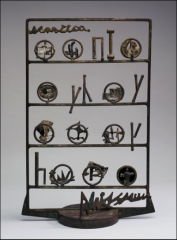
|
David Smith "The Letter" 1950 Abstraction/Existentialism *Like steel drawings in space |
|
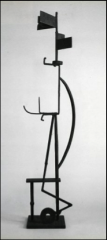
|
David Smith "Sentinal" 1957 Abstraction/Existentialism *Elements from farm or industrial machinery *Found Objects - Smith integrated such objects in the whole structure so that their original function was subordinated to the totality of the new design *voids do not merely surround mass but are articulated by form *not isolated on a pedestal but occupies the viewer's actual space |
|
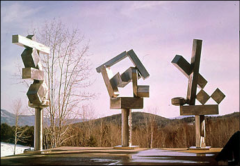
|
David Smith "Cubi XVIII", "Cubi XVII", "Cubi XIX" Abstraction/Existentialism *Highly reflecting light-saturated surfaces *The work communicates an intimate sense of the artist's touch *His art was critical to the development of the more impersonal creations of Minimalist artists in the 1960's |
|
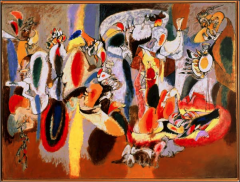
|
Arshile Gorky "The Liver is the Cock's Comb" 1944 Abstract Expressionism *Inspired by his father's garden in Sochi when he was a child - before Armenian genocide *Influenced by Kandinsky, Miro, automatism of abstract surrealists *Resembles both a wild and vast landscape and a microscopically detailed internal anatomy *Veiled but recognizable shapes *Overtly sexual forms *Erotically charged atmosphere filled with |
|

|
Jackson Pollock "Going West" 1934-35 Abstract Expressionism *Influenced by Thomas Hart Benton - the rhythmic movement of form in Benton's work |
|
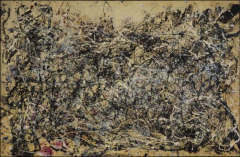
|
Jackson Pollock "One" 1948 Abstract Expressionism/ "action/drip painting" *Went to Jungian therapist to try to deal with his alcoholism and white there, he drew automatic drawings to release the demons from his unconscious *Handprints along edges - detaching himself from his art *Notion of canvas as an "arena" - Pollock used unprimed, unstretched canvas that he rolled onto the floor of his studio *Introduced an element of chance and accident and at the same time, he was very deliberate in placement of each drip/thrown line of paint to build up a web of color that creates illusion of very shallow depth, while at the same time asserting a flatness of the painting *Influenced by navaho sand painting - a "happening", a record of an event, a heroic break from tradition, it becomes a moment, a process, act, gesture |
|
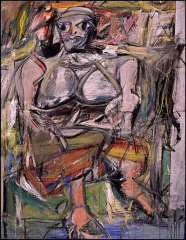
|
Willem de Kooning "Woman I" 1950 Abstract Expressionism/ "action painting" *Criticized as a violent, misogynist rendering of female form, but he claimed he simply used the iconic female nude as a point of departure for his exploration of painting *Aesthetic tension *Appears entirely improvisatory, but the artist labored over the painting for 18 months *Perceived a relationship between the comic and the terrifying, a relationship he projected onto the female body - "The female painted through all the ages, all the idols" *Feminine within himself *Unapproved by Clement Greenberg because it depicts something/tells a story and that belongs in literature, not painting |
|
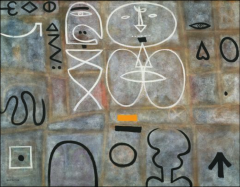
|
Adolph Gottlieb "Man Looking at Woman" 1949 Abstract Expressionism *Objects picked up from the desert (Arizona) and arranged within rectangular compartments *Pictographs (implies prehistoric cave paintings); filled with ideograms *Composed his paintings intuitively, drawing on automatist methods as well as on his interest in ancient myth and ritual *Influenced by various sources: Mondrian, Klee, Cubists, African and Native American art - provided him with powerful lexicon of mysterious signs, which he assembled to form what he believed t be a new, universal language |
|
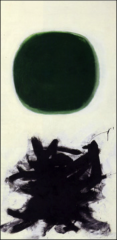
|
Adolph Gottlieb "Burst II" 1957 Abstract Expressionism *From his "Bursts" collection *Cosmic landscapes usually consisting of upper circular/ovoid elements suggestive of a burning sun and below, a broken,exploding element, open and dynamic in contrast with the closed form above *Underscore life's fundamental dualities and conjure up landscapes at the dawn of civilaztion |
|

|
Adolph Gottlieb "Duet" 1962 Abstract Expressionism *From his "Bursts" collection *Cosmic landscapes usually consisting of upper circular/ovoid elements suggestive of a burning sun and below, a broken,exploding element, open and dynamic in contrast with the closed form above *Underscore life's fundamental dualities and conjure up landscapes at the dawn of civilaztion |
|
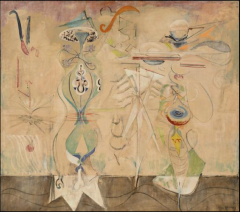
|
Mark Rothko "Slow Swirl by the Edge of the Sea" 1944 Abstract Expressionism *Biomorphic, Surrealist-inspired, hybrid creatures floating in primordial waters |
|
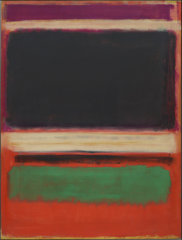
|
Mark Rothko "Untitled (Magenta, Black, Green on Orange)" 1949 Abstract Expressionism *The untitled painting=ambiguity of 20th century artists *Floating color shapes with loose, undefined edges within larger expanses of color *Refined and simplified his shapes to the point where they consisted of color rectangles floating on a color ground *Luminous color effects and a shifting ambiguous space *Designed to absorb and engulf the spectator - the effect of enclosing, encompassing color |
|
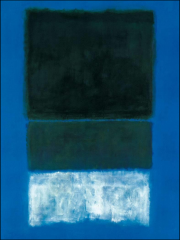
|
Mark Rothko "Untitled (White and Greens in Blue)" 1949 Abstract Expressionism *Floating color shapes with loose, undefined edges within larger expanses of color *Refined and simplified his shapes to the point where they consisted of color rectangles floating on a color ground *Luminous color effects and a shifting ambiguous space *Designed to absorb and engulf the spectator - the effect of enclosing, encompassing color |
|
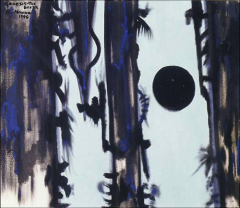
|
Barnett Newman "Genesis: The Break" 1948 Abstract Expressionism *Shares many traits with Rothko's biomorphic paintings *Forms become more abstract and begin to shed their biological associations |
|
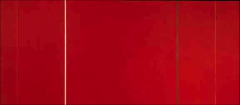
|
Barnett Newman "Vir Heroicus Sublimis" 1950-51 Abstract Expressionism *No technical skill *Pure abstraction *Multiple zips contrast with stark monochrome background *Newman wanted to maintain a human scale for his essentially life affirming, humanistic art *Title="Heroic Sublime Man *Zips=read as a sign for the upright human being |
|
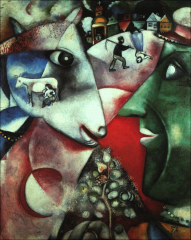
|
Marc Chagall "I and the Village" 1917 Fantasy/Metaphysical School * |
|

|
Carlo Cara "Metaphysical Muse" 1917 Fantasy/Metaphysical School * |
|
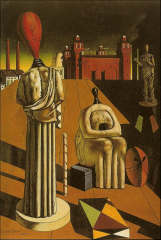
|
Giorgio di Chirico "Disquieting Muses" 1925 Fantasy/Metaphysical School *Drawing upon classical works, but placing them in other worldly settings |
|
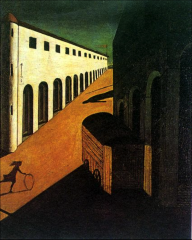
|
Giorgio di Chirico "The Melancholy and Mystery of a Street" 1914 Fantasy/Metaphysical School *Go from tangible reality -> metaphysical mindset in order to fully understand |
|
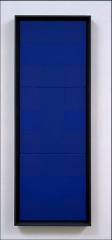
|
Ad Reinhardt "Abstract Painting: Blue" 1952 Late Formalist Modernism/Greenberg's High Modernism *"Art as art as art" -Has nothing to do with the issues of either daily life or existential doubt - "art is art and life is life" *Simplified his palette to a single color *9 small squares (variations of blue hues) that are representations of the whole piece; second inner image - art about art *No visible brushstrokes *Rewards the slow looking and are powerfully hypnotic in their effect |
|
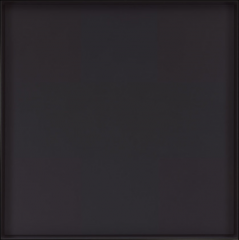
|
Ad Reinhardt "Abstract Painting: Black" 1966 Late Formalist Modernism/Greenberg's High Modernism *"Art as art as art" -Has nothing to do with the issues of either daily life or existential doubt - "art is art and life is life" *Simplified his palette to a single color *9 small squares (variations of blue hues) that are representations of the whole piece; second inner image - art about art *No visible brushstrokes *Rewards the slow looking and are powerfully hypnotic in their effect |
|
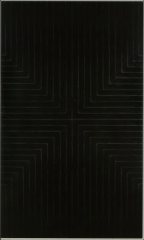
|
Frank Stella "Die Fähne Hoch!" (The High Flag) 1959 Formalist Modernism *Jasper Johns' flag *Symmetrical *In balanced symmetry and repetition of identical motifs, his paintings had a compelling power of their own, which led modernist critics to praise their optical qualities
|
|

|
Frank Stella "Empress of India" 1965 Formalist Modernism
|
|
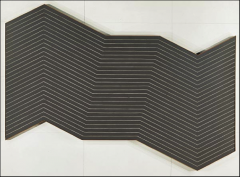
|
Frank Stella "More or Less" 1964 Formalist Modernism *Greenberg's notion of "self criticism"=work of art critiquing itself (nothing to do with the artist) *Shaped canvas - why does the painting have to conform to the shape of the canvas? *Asserts its objectness *Greenberg hated it oddly enough because it was a violation to everything sacred about art - not a painting anymore, it became a sculpture; it acts like theater - it confronts the viewer and get in their space |
|
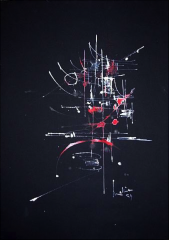
|
Georges Mathieu "Emblema" 1959 Post-Modernism/Performance art *Consists of sweeping patterns of lines squeezed directly from the tube in slashing, impulsive gestures *To him, speed of execution was essential for intuitive spontaneity *When he performed in front of an audience, he dressed in armor and attacked the canvas *During performances, he painted with great rapidity as if to emphasize the centrality of intuition and instinct in his process |
|
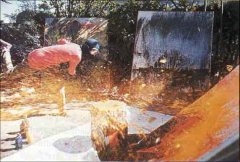
|
Shozo Shimamoto "Hurling Colors" 1956 *"Guati" = idea of the canvas becoming an arena *Blended traditional shinto beliefs into modernism - he had the utmost respect for his materials like the shinto respect nature *Canvas became a record of the event *He threw glass bottles filled with paint at the canvas - glass shards, dirt, and blood scarred and stained the canvas
|
|
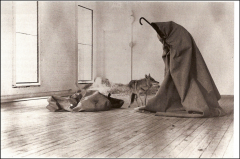
|
Joseph Beuys "I Like America and America Likes Me" 1974 FLUXUS - investigating how things are influxed in modern day *Plane shot down while in the war, rescued by the tartar (indigenous people) who nursed him back to health and he returned to Germany *Wanted to heal the world and he used installation/performance art in order to do so *America in a global context - encroached upon coyotes *they est. their separate spaces (human and animal) |
|
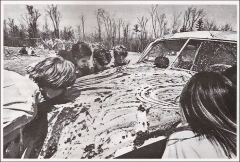
|
Alan Kaprow "Household" 1964 Post-Modernism/A "Happening" *Interested in the gap between life and art *Rules for the Happening -no documentation -cannot script, but can plan it (instructions) -not supposed to be for an audience *art about art/act is for the act itself |
|
|
POP! |
*Popular *Transient (short-term solution) *Expendable (easily forgotten) *Low cost *Mass produced *Aimed at the youth *Witty, Sexy, Gimmicky, Glamorous and Big Business *Purpose was not entirely satirical or antagonistic *Pop artists looked at the world in which they lived and examined the objects and images around them with intensity and penetration, frequently making the viewer conscious of that omnipresence for the first time *Rich with irony and humor |
|

|
Richard Hamilton "Just What Is It That Makes Today's Homes So Different, So Appealing?" 1956 POP! *Social/political commentary *Sexualizing women, moon on the ceiling, first talkie advertised in the window, wife cleaning *a "modern" apartment inhabited by a pin-up girl and her muscle-man - like an adam and eve in a consumers' paradise *Products of mass culture - the images provide a kind of inventory of visual culture |
|

|
Andy Warhol "Marilyn" (all three) 1962 POP! *Appropriated images from the media *Used a mechanical photo-silkscreen process that further emphasized his desire to eliminate the personal signature of the artist to depict the life and the images of his time *Allowed layers of silkscreen colors to register imperfectly, thereby underscoring the mechanical nature of the process and encouraging observers to contemplate the fate of the then recently deceased Monroe. |
|
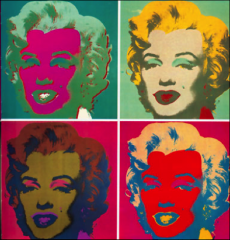
|
Andy Warhol "Marilyn" 1967 POP! |
|

|
Andy Warhol "Brillo Boxes" 1964 POP! |
|

|
Robert Rauschenberg "Monogram" 1959 Somewhere in between abstract expressionism and POP! *"Combine painting" *"Act in the gap between art and life" *Free brush painting acts as a unifying element *Composed of disparate elements that do not coalesce into any single. unified meaning or narrative *Expands our very definitions of art |
|
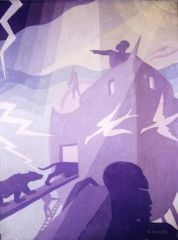
|
Aaron Douglas "Noah's Ark" 1927 Harlem Renaissance/"afro-deco" *New Negro Movement = movement in art/literature that was encouraged by black and white philanthropists/intellectuals -idea: counter negative stereotypes and racism that had developed through encouraging production of art/literature/music to demonstrate cultural parody with white american society *Studied cubism, stories of African American people *African style carvings/representational elements of that culture, along with Egyptian styles, cubist/modern style blended together |
|
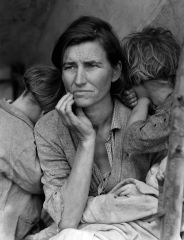
|
Dorothea Lange "Migrant Mother, Nipomo Valley" 1935 Documentary Photography *Woman looks very old, but she's actually only in her 30's *Within days of its publication/release to the public, people started sending $ and supplies to Nipomo Valley |
|

|
Edward Hopper "Nighthawks" 1942 American Scene Painting *Desire to create paintings with a modern approach that still reflected characteristics of the American experience *Notion that Americans had followed European art for some time and it was time to create "American" art |
|
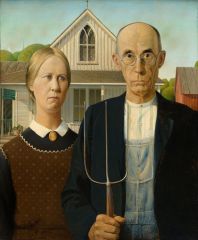
|
Grant Wood "American Gothic" 1930 American Scene Painting *Wood's dentist and his sister - irony |
|
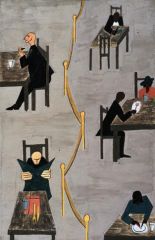
|
Jacob Lawrence "No. 49" 1940-41 *NOT part of Harlem Renaissance - too young at the time *Influenced by a combo of abstract approaches to representation with regionalist/American scene painting tendencies to depict the American experience - specifically, the african american experience |

